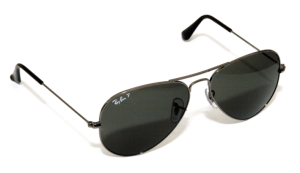The Difference between Polarized and Non-Polarized Lenses
 You’ve heard of polarized sunglasses, but aren’t sure how they’re different from other sunglasses or how they work. Here we discuss the difference between polarized and non-polarized lenses and the benefits they could have for you.
You’ve heard of polarized sunglasses, but aren’t sure how they’re different from other sunglasses or how they work. Here we discuss the difference between polarized and non-polarized lenses and the benefits they could have for you.
How Polarized Lenses Work
Polarized lenses are made to reduce the amount of glare and so increase visual acuity on a bright day. Polar light comes from horizontal waves, which creates glare. To reduce or neutralize the glare on water or shiny, light-coloured objects, polarized lenses have a protective layer that uses vertical light filters to cancel out horizontal light.
When you wear polarized sunglasses, the only light waves getting through the applied filters are vertical, which is what you need to be able to see things in daylight. Horizontal rays get trapped in the vertical filters to reduce reflections.
Advantages of Polarized Lenses
If you enjoy the great outdoors, the advantages of wearing polarized sunglasses are significant. Polarized lenses cut down on the glare coming off the water when you’re fishing, allowing you to see through the water on bright days.
Polarized lenses are good for playing sports because they reduce the amount of light interference that comes from reflective objects, like passing cars, and help to clarify the difference between real things and glare-related optical illusions.
Polarized lenses also help to reduce the glare coming off of cars while driving and improve on the lack of precision that sometimes comes from regular sunglasses.
Disadvantages of Polarized Lenses
For some people, wearing polarized lenses can make them feel dizzy and disoriented. They are also not tech-friendly because the lens coatings make it difficult to read LCD screens. That means you won’t be able to use your phone while wearing your glasses, although that may not be the case with some brands.
Although many modern aviator style glasses come with polarized lenses, they can be a bad idea if you’re a pilot because the screens on instrument panels in airplanes are usually already polarized. In that case, wearing polarized lenses can make vision worse.
Types of Polarized Lenses
There are two types of polarized lenses; .75 mm and 1.1 mm. The .75 mm polarized lenses are made from thin sheets of film and are best when you don’t have to worry about impact resistance, as in most casual sports like running and golf.
1.1 mm polarized lenses are made with thicker sheets of film to offer more impact resistance than .75 mm lenses. Both have the same polarizing layer and 1.1 mm film, although thicker, doesn’t offer better glare reduction or higher polarization. The added thickness usually only makes them more durable and therefore, more expensive.
Tinted Lenses vs. Polarized Lenses
Tinted sunglasses are great for reducing brightness but they don’t eliminate harsh glare like polarized sunglasses do. The darkness of the lens doesn’t accurately represent the lenses’ ability to block UV rays, either.
Always check the label on any sunglass purchase to see what level, if any, of UV protection they offer. It’s good to remember that dark sunglasses without UV protection can actually cause more damage to your eyes than not wearing sunglasses at all. Darker tints can cause the pupil to dilate, letting more harmful UV rays into the inner part of the eye.

